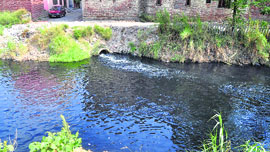Ludhiana, Punjab: Buddha Nullah, once called Buddha Dariya, tells the story of the deterioration of the city’s environment. A clean water rivulet with fishes of myriad varieties swimming in it is how the nullah (drain) is remembered as by those who have seen it in 1960s. Today, the erstwhile dariya (river) has turned black with effluents discharged by industries and domestic sewage disposed into it every day. It is lifeless and it stinks.
The pollution of Buddha Nullah, leading to the pollution of Sutlej River, is only one example of the rising pollution in the city—dubbed as the Manchester of India.
City’s air quality, too, has been affected severely. Industrial plants, swelling number of vehicles in absence of effective public transport system and burning of agricultural stubble and garbage are choking the air with harmful gases.
The city has been figuring as one of the most polluted cities in the world on the World Health Organisation list repeatedly.
As per the WHO report this year, the particulate matter (PM) levels of the city are much higher than the safe limit of 25 micrograms.
While PM 10 (particles with diameter of 10 microns) is 207 micrograms per cubic metre, PM 2.5 is 91 micrograms per cubic metre in Ludhiana. Three years back, the city was rated as the fourth most polluted city in the world.
There are more than 15 lakh vehicles in the city according to the District Transport Office. The incessant honking and dangerous emissions continue to contribute to noise and air pollution.
Toxic gases such as sulphur dioxide, carbon monoxide and hydrocarbons emitted by automobiles and industrial plants pose a major health hazard. Cases of respiratory diseases are on the rise, say doctors.
Unregulated flow of traffic in various parts of the city leads to traffic jams. Vehicles, thus stuck, keep emitting gases, making these areas hubs of air pollution. The administration has promised to strengthen the city bus service and plans to introduce CNG auto-rickshaws and bus rapid transport system. Everything, however, remains on papers. Despite the submission of a report to the state government by the Delhi Metro Rail Corporation five years back, the project is yet to take off.
The Punjab Pollution Control Board officials say treatment plants were being set up at various places, such as a zero liquid discharge common effluent treatment plant at Baharke Road. The state government, too, announced that existing sewage treatment plants at Bhattian, Jamalpur and Balloke would be upgraded and a new plant would come up at Jamalpur. Results are still to be seen.
“A lot of projects are announced and cleanliness initiatives are taken, but pollution keeps rising,” said Sarabjit Singh, a resident.
Ranjodh Singh, an industrialist, said that although a major stress was being given on air and water pollution, noise pollution was not getting much attention.
He said there was no collective effort on the part of industrialists to make the city pollution-free.
Source: The Tribune
 Sikh Sangat News Celebrating Sikh culture and sharing Sikh voices
Sikh Sangat News Celebrating Sikh culture and sharing Sikh voices

